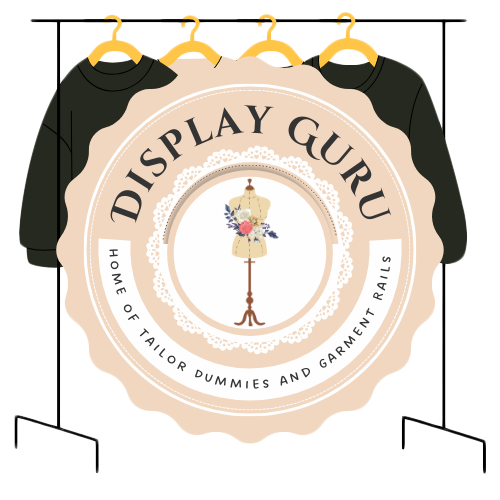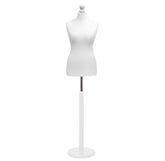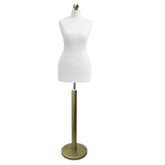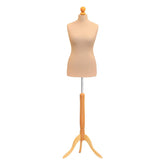Mannequin in Shops A Visual Merchandising Guide
A mannequin in a shop is so much more than a lifeless hanger for clothes; it’s your most effective silent salesperson. A thoughtfully styled mannequin can stop a passer-by in their tracks, instantly communicate your brand's essence, and subtly guide a customer’s journey through your store. For any UK retailer, it's an absolutely critical asset.
Your Shop's Most Powerful Silent Salesperson
It's time to rethink how you see the mannequins in your shop. They aren't just plastic figures; they are dynamic storytellers that translate abstract style concepts into tangible, desirable outfits. When a potential customer sees a complete look put together on a form, it takes the guesswork out of styling and plants a seed of aspiration. This is where visual merchandising really starts to drive sales.
Putting your mannequins to work effectively means going beyond just chucking the latest arrivals on them. It’s about creating a narrative. Is your brand edgy and urban, or is it classic and sophisticated? The pose, the styling, and even the type of mannequin you choose should answer this question at a glance. They are, quite literally, the first handshake you offer to anyone walking past or stepping inside.
The Evolution of the Silent Salesperson
Mannequins have a history that's deeply woven into the fabric of fashion retail. Their use in the UK, in particular, has a rich lineage, evolving from basic dress forms to the sophisticated brand ambassadors we see today. The Industrial Revolution kicked off mass production, and by the early 20th century, mannequins were fixtures in the grand, new department stores of London and Manchester.
They’ve always reflected the times, from the highly stylised, elegant figures of the 1930s to the iconic, slender Twiggy-inspired forms of the 1960s, which perfectly captured the spirit of the era.
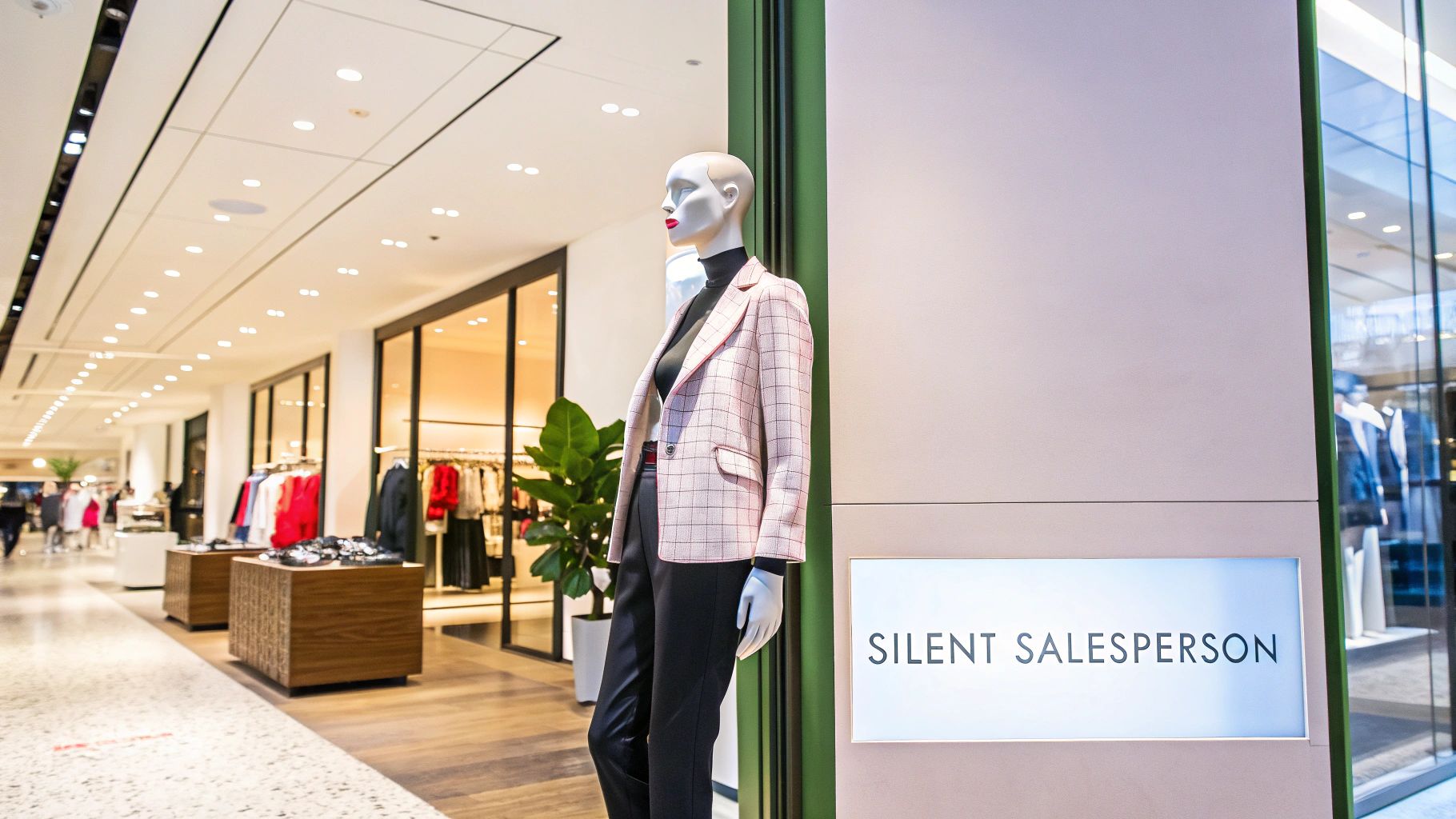
Beyond Display to Strategic Tool
Ultimately, your mannequins are a core part of a much bigger picture. They need to work in harmony with your store layout, lighting, and product placement to create an experience that feels compelling and authentic. A strategically placed mannequin can do some heavy lifting for you.
- Highlight Key Collections: Immediately draw the eye to high-margin items or seasonal campaigns.
- Demonstrate Versatility: Show customers how to mix and match pieces they might not have considered putting together themselves.
- Increase Dwell Time: An engaging display encourages shoppers to slow down, look around, and spend more time exploring what you have to offer.
By mastering the art of the mannequin, you transform a static object into a profitable tool that speaks directly to your ideal customer without ever saying a word.
This guide moves past the basics, giving you practical, actionable strategies to select, style, and position your mannequins for maximum impact. For an even deeper dive, our comprehensive visual merchandising guidelines offer more tips to elevate your in-store displays and boost your sales.
How To Select the Perfect Mannequin for Your Brand
Choosing a mannequin is one of the most direct ways to invest in your brand's identity. This isn't just about picking a fixture to hang clothes on; it's about selecting a silent salesperson, a physical ambassador that embodies your shop's entire aesthetic. It’s what speaks to your target customer before they’ve even touched a single garment.
The right choice can turn a simple clothing display into a compelling story. So, where do you start?
It all begins by matching the mannequin's style to your shop's personality. Think about your ideal customer. What message are you trying to send?
A high-end boutique that prides itself on sharp, modern tailoring would find a perfect partner in sleek, abstract mannequins. Their minimalist forms don't distract; instead, they draw the eye straight to the garment's cut, texture, and silhouette, creating a sense of sophistication and artistry.
On the other hand, a shop selling casual, family-focused apparel would do better with realistic mannequins. With their detailed facial features and dynamic poses, they help shoppers instantly picture the clothes in their own lives. It makes the outfits feel less like products on a shelf and more like a part of their world.
Aligning Mannequin Types with Your Brand
Getting to grips with the different categories is the first real step to making a smart decision. Each type serves a distinct visual purpose and connects with a completely different consumer mindset.
Here’s a quick rundown to get you thinking:
- Realistic Mannequins: These are your storytellers, perfect for creating relatable lifestyle scenes. They excel at showing exactly how an outfit fits and moves, making them a fantastic choice for mainstream fashion, sportswear, and family clothing brands.
- Abstract Mannequins: Ideal for luxury, avant-garde, or minimalist brands. By removing specific features, they place all the focus on the clothing's design and form, creating an aspirational, gallery-like atmosphere.
- Headless Mannequins: This is a wonderfully versatile and cost-effective middle ground. You get a realistic body shape that shows off the fit, but without any distracting facial features, allowing the clothing to remain the hero. They work for almost any setting, from small independent boutiques to large department stores.
- Inclusive Body Forms: Truly essential for any brand committed to representing a diverse customer base. Using mannequins that reflect varied body shapes and sizes sends a powerful, unspoken message of inclusivity. It helps a much broader range of customers see themselves in your products.
To make this choice clearer, let's compare how each mannequin type aligns with different brand goals.
Mannequin Type and Brand Alignment
Making the right choice is a strategic move. This table breaks down which type of mannequin best suits different retail environments and the brand image they help create.
| Mannequin Type | Best For | Brand Image | Material Considerations |
|---|---|---|---|
| Realistic | Mainstream fashion, sportswear, department stores | Relatable, accessible, family-oriented | Often fibreglass to capture fine detail |
| Abstract | High-end boutiques, luxury brands, art galleries | Sophisticated, minimalist, aspirational | Fibreglass, resin, or high-gloss plastic |
| Headless | Independent boutiques, versatile retail spaces | Modern, product-focused, neutral | Fibreglass, plastic; lightweight options available |
| Inclusive | All modern brands, especially lingerie and apparel | Inclusive, body-positive, authentic | Can be found in fibreglass, plastic, or eco-friendly materials |
Ultimately, your choice here directly influences how customers perceive your clothing and your brand as a whole.
The Material World: The Impact of Construction
The material your mannequin is made from has a bigger impact than you might think. It affects durability, weight, cost, and can even say something about your brand's commitment to sustainability.
For years, fibreglass has been the industry standard. It’s strong and holds fine details incredibly well, making it a go-to for realistic displays. Its dominance is clear, as fibreglass accounted for 68.51% of total revenue in the thriving UK mannequin market in 2023. This market, valued at USD 278.2 million last year, is projected to keep growing, proving just how vital physical displays still are.
But the world is changing, and more brands are looking for alternatives.
Choosing a mannequin is not just a practical decision; it is a declaration of your brand's values. A sustainable material or an inclusive body shape can communicate your ethos more powerfully than any marketing slogan.
Lighter-weight plastics, for instance, are far easier for staff to move and dress. Meanwhile, eco-friendly options made from recycled materials can become a key part of your brand's green credentials. Think about the day-to-day practicalities of your retail space and the values you want to project when making your final decision.
For a more detailed look at the options available, check out our complete guide to different types of mannequins for shops. It offers a deeper comparison to help you find the perfect fit.
Styling Techniques That Inspire Purchases
A mannequin is more than just a clothes horse; it’s your silent salesperson. The goal isn’t just to put clothes on a form, but to create an aspirational look that stops a customer in their tracks and makes them think, "I need that."
Effective styling tells a story. It shows shoppers not just what to buy, but how to wear it, transforming a simple display into a powerful sales driver. The real magic happens when you move beyond a single garment and build a complete, head-to-toe ensemble.
The Art of Layering and Colour
Layering is one of the most powerful tools in a visual merchandiser's arsenal. It adds depth, texture, and a sense of completeness that makes an outfit feel more premium. Think about it: a crisp shirt under a chunky knit, topped with a tailored jacket, doesn't just show off three products—it shows off a fully realised look.
Colour is just as critical. You can go bold with complementary colours that really pop and grab attention from across the shop floor. Or, for a more sophisticated vibe, try a monochromatic look, playing with different shades and textures of the same colour. Don't be afraid to experiment with colour palettes that echo current trends or scream your brand's identity.
A well-styled mannequin doesn't just display products; it solves a customer's problem. By showing them a complete, ready-to-wear outfit, you remove the guesswork and make the purchasing decision feel effortless and inspiring.
This infographic breaks down the hierarchy of decisions you need to make when selecting your mannequins, starting with your core brand identity and filtering down to the specifics of body type, material, and pose.
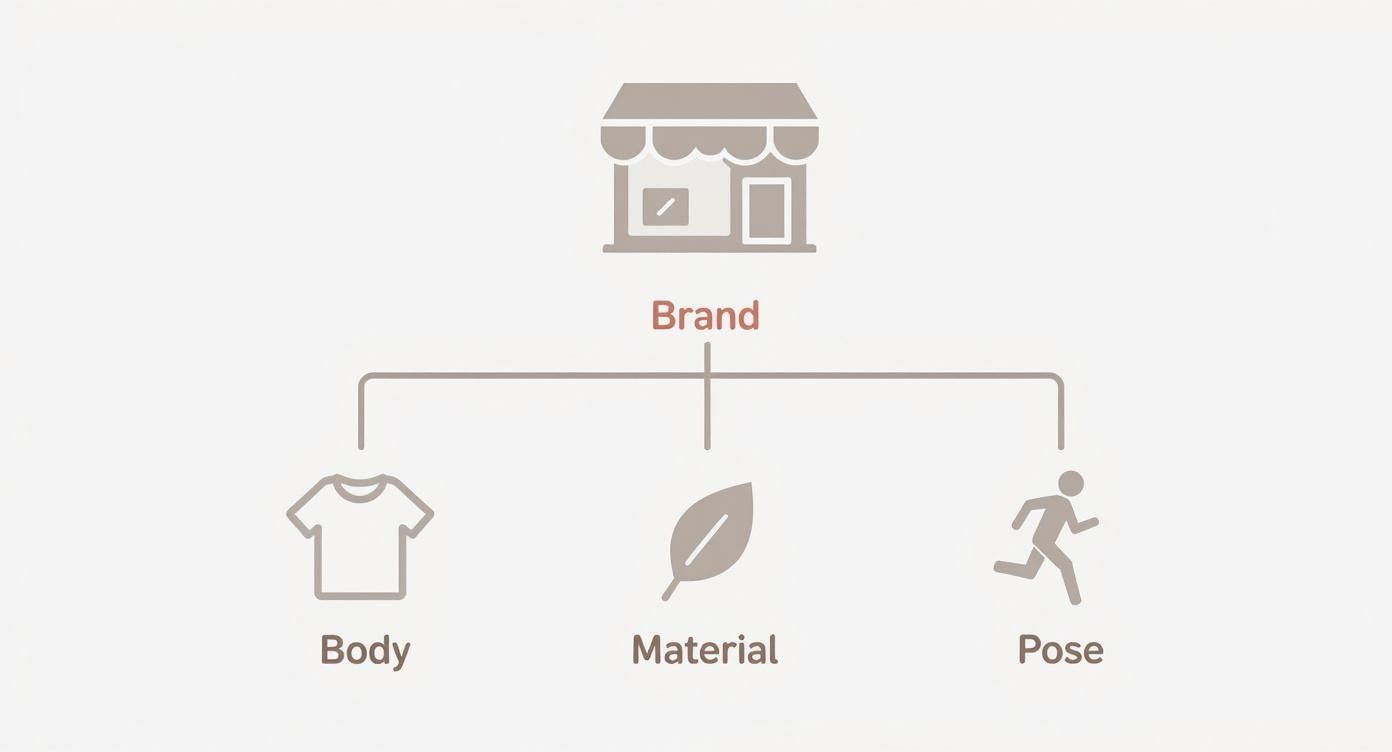
As you can see, every choice, from the form itself to the finish, should flow directly from your brand's story to create a consistent and compelling message for your customers.
Finishing Touches and Strategic Upselling
The difference between an amateur display and a professional one often comes down to the small details. First rule: no garment should ever touch a mannequin unless it has been pristinely steamed or ironed. Wrinkles and creases can make even the most luxurious fabrics look cheap.
Next, get comfortable with using pins. A few discreetly placed pins can tailor the fit, making sure every garment hangs just right. A perfectly fitted piece of clothing simply looks better and more desirable—it’s a simple trick the big retailers use to give their stock a polished, almost bespoke feel. For a deeper dive into getting it just right, check out our expert tips on how to dress a mannequin for maximum impact.
Finally, remember that every styled mannequin is a golden opportunity to upsell. Always finish the look with high-margin accessories.
- A stylish handbag that picks up on a colour in the outfit.
- A scarf draped effortlessly around the neck to add texture.
- The perfect pair of shoes, placed neatly at the mannequin's base.
These aren't just decorative touches. They complete the story and plant the seed for a larger purchase. By showing how beautifully different items work together, you significantly increase the odds of a multi-item sale and give your average transaction value a healthy boost.
Strategic Placement to Guide Customer Flow
Where you place your mannequins is just as important as the outfits you put on them. Think of it less as filling empty space and more as a deliberate visual merchandising tactic. Your goal is to guide the customer's journey through your shop, shine a spotlight on key products, and ultimately, drive sales. Your mannequins are silent storytellers, strategically positioned to shape how shoppers experience your brand.
That first point of contact when a customer walks in is arguably the most critical. We call the area just inside the entrance the 'decompression zone'. This is where shoppers mentally shift gears from the outside world and adjust to your store's atmosphere. A striking mannequin display right here creates a powerful first impression, instantly communicating your style and setting the tone for their entire visit.
The key is not to overwhelm this space. A single, perfectly styled mannequin or a small, dynamic group is far more effective than a cluttered mess. This initial display should feature your most exciting new arrivals or a signature look that perfectly captures your current collection.
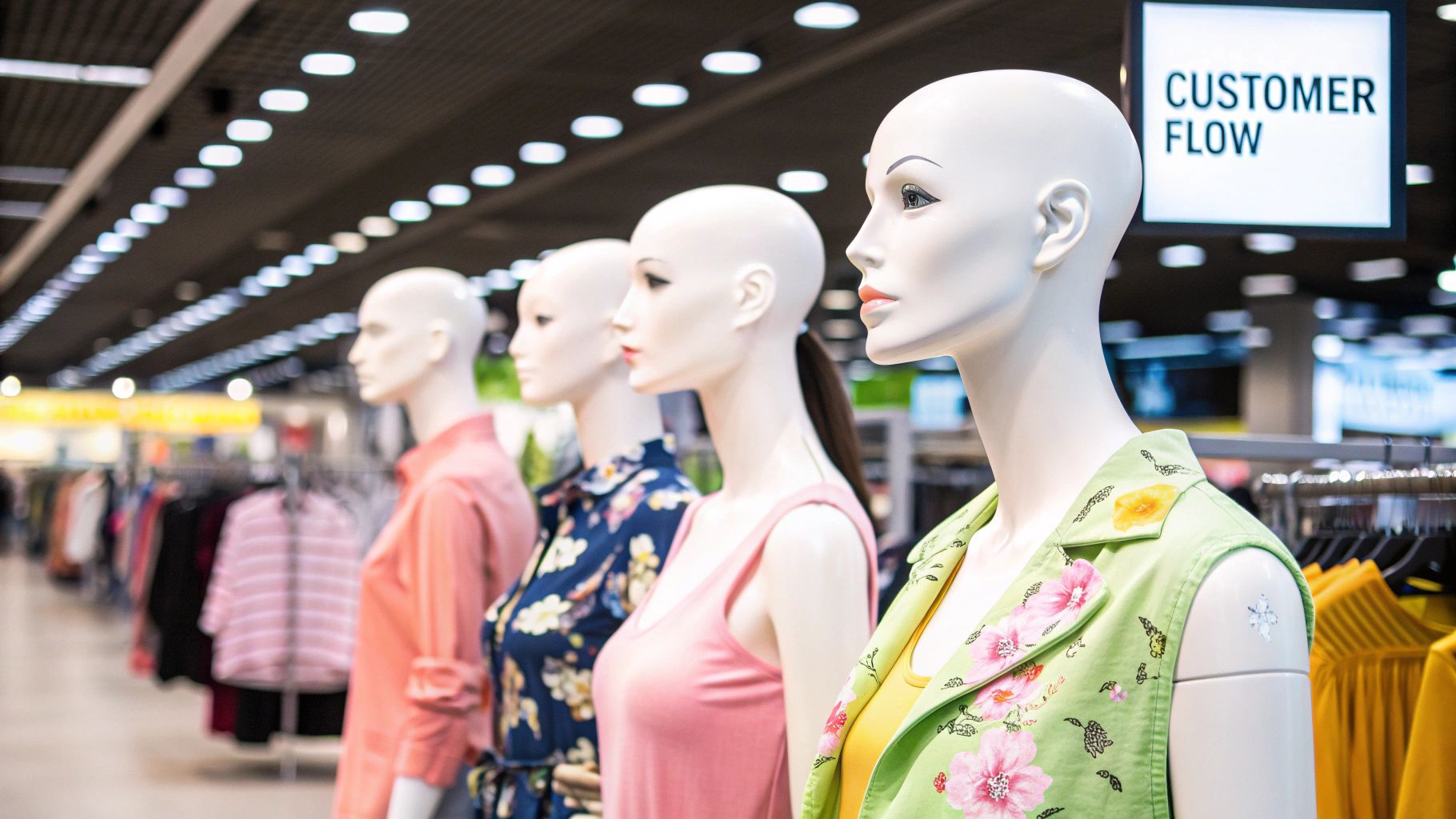
Creating Compelling Scenes with Groups
Bringing mannequins together allows you to build a narrative and showcase more complex looks. This is your chance to create a scene that tells a story—maybe it's a family dressed for a weekend walk or a group of friends ready for a night out. This approach helps customers visualise how the clothes fit into their own lives.
A classic principle in visual merchandising is the 'Rule of Three'. Grouping mannequins in odd numbers, especially threes, is naturally more appealing and dynamic to the human eye. It creates an effortless focal point and dodges the static, symmetrical look that paired displays can sometimes have.
When you're grouping them, try these tactics:
- Create a Pyramid: Arrange three mannequins at different heights or depths to form a pyramid shape. This naturally guides the viewer's eye across the whole setup.
- Suggest Interaction: Position them as if they're mid-conversation, perhaps turned towards each other. This injects a sense of life and movement.
- Keep it Cohesive: Make sure all mannequins in a group are styled around a single, consistent theme, whether that’s a colour story, a specific trend, or a seasonal collection.
High-Impact Zones Beyond the Entrance
Once customers are inside, your mannequins need to keep guiding them. Position displays at the end of aisles (known as endcaps) and along major sightlines. These are prime spots for grabbing attention and pulling shoppers deeper into the store. A well-lit mannequin at the back of the shop can even act as a beacon, encouraging people to explore the full space.
Your displays aren't just decorative; they're strategic tools. Every placement decision should be made with the goal of controlling traffic flow, boosting product visibility, and making the shopping experience more intuitive and engaging.
The importance of these in-store strategies has become even clearer as physical retail bounces back. During the pandemic, store closures meant mannequins were largely out of sight. Major UK retailers like H&M reported a 20% revenue drop in 2020, partly due to their limited physical operations. As doors reopened, the strategic use of mannequins became vital for breathing new life into the in-store experience and kick-starting sales. You can find more insights on the recovering mannequin market here.
Finally, always make sure the products on display are easy to find. There’s nothing more frustrating for a customer than seeing a fantastic outfit on a mannequin and then having to hunt for the items. Stock the clothes on nearby racks, tables, or other complementary display stands for clothing to create a seamless journey from inspiration to purchase.
Keeping Your Mannequins in Perfect Condition
https://www.youtube.com/embed/_FkLfF0vdgU
Your mannequins are a serious long-term asset, and like any good investment, they need looking after. A chipped, dusty, or scuffed mannequin can quietly undermine your whole brand image, sending a message that you don't care about the details. Consistent maintenance is key to making sure your silent sales team always looks sharp and professional.
This isn’t a massive time-sink, but it does need to be part of a regular routine. Just think of it as another piece of your visual merchandising puzzle—it needs active management to work. After all, a pristine display speaks volumes about the quality of the clothes it’s showing off.
Of course, the overall cleanliness of your shop plays a huge role here. To keep the entire environment around your displays looking immaculate, it helps to follow a structured retail store cleaning checklist.
Routine Cleaning and Scuff Removal
A quick dusting should be part of your daily opening or closing duties. Grab a soft, microfibre cloth and give every surface a gentle wipe, paying extra attention to the shoulders and head where dust loves to settle. This simple act prevents build-up and keeps them looking brand new.
For those more stubborn marks on fibreglass models, a magic eraser sponge can be a lifesaver for light scuffs. If you’re working with a painted finish, opt for a gentle, non-abrasive cleaner and a soft cloth, but always test it on a small, hidden spot first just to be safe.
Plastic forms are usually a bit more forgiving and often just need a quick wipe with a damp cloth. The big thing to remember is to stay away from harsh chemical cleaners, as they can eat away at the finish over time.
Safe Handling and Storage
Believe it or not, most damage happens when mannequins are being put together, taken apart, or moved around the floor. Always handle the individual parts with care, making sure not to put too much stress on the joints—the wrists, shoulders, and waist connections are especially vulnerable. When you're disassembling them, lay the pieces out on something soft, like a blanket, to avoid any accidental scratches.
Proper storage is just as crucial, particularly if you swap out your mannequins with the seasons.
- Wrap Each Part: Use bubble wrap or soft fabric to individually cover the arms, legs, and torsos. This stops them from banging into each other and causing chips or cracks.
- Store Horizontally: If you have the space, it's much better to store the parts lying down on shelves. Standing them up can put unnecessary pressure on weak points.
- Avoid Direct Sunlight: Keep your stored mannequins well away from windows. Long-term exposure to UV rays can make the finish fade or go yellow.
Treat your mannequins with the same respect you give your merchandise. If you do, you'll dramatically extend their lifespan and ensure they remain a valuable, eye-catching asset for your shop for years to come.
Answering Your Mannequin Questions
Even with a solid strategy in place, the day-to-day reality of working with mannequins throws up plenty of practical questions. Getting straight answers to these common challenges can make all the difference, saving you time and sharpening the impact of your visual merchandising.
Let's dive into a few of the queries we hear most often from retailers.
How Often Should I Change My Mannequin Outfits?
For your prime real estate – the window display and anything right by the entrance – you should be aiming for a refresh every one to two weeks. This keeps your storefront looking fresh and exciting, giving regulars a genuine reason to see what’s new. After a while, a static display just becomes part of the background noise.
For the mannequins further inside the shop, changing the outfits every two to four weeks works well. A good rule of thumb is to sync these changes with new stock arrivals. The key is consistency. A dusty, forgotten mannequin sends a message that your stock might be neglected too, so a regular schedule is vital.
Are Realistic or Abstract Mannequins Better for Sales?
This is a classic question, but there’s no single right answer. It all comes down to your brand identity and the story you're trying to tell. It’s less about which is 'better' and more about which one is the right fit for your customer.
- Realistic mannequins are brilliant for helping shoppers imagine themselves in the clothes. Their familiar, relatable forms are perfect for classic apparel, lifestyle brands, and family-focused retailers.
- Abstract mannequins, on the other hand, create a more artistic, high-fashion vibe. They strip away distractions, pulling the customer's focus directly to the garment’s cut, fabric, and design. This makes them a natural choice for luxury, minimalist, or avant-garde boutiques.
The biggest mistake retailers make is simple neglect. A dusty, poorly dressed, or chipped mannequin instantly damages your brand's reputation. Think of them as valuable assets that need regular care.
Another common pitfall is styling a mannequin in an outfit where one of the items is out of stock. It's a recipe for customer frustration and a guaranteed lost sale. Always make sure the complete look is available nearby. Getting the form right from the start is also crucial, so understanding the specifics of mannequin measurements can head off a lot of styling headaches.
What Is the Future of Mannequin Displays?
While the physical mannequin isn’t going anywhere, the future is definitely pointing towards more dynamic, tech-driven displays. We're starting to see some fascinating innovations that could change how we think about in-store presentation. For instance, generative AI is now capable of creating 3D models from simple text prompts. Exploring topics like Mastering text-to-3D model conversion gives us a glimpse into how virtual mannequins and interactive digital displays could soon become a powerful new tool for engaging shoppers.
At Display Guru, we specialise in providing the high-quality, durable mannequins and display forms you need to make your visual merchandising vision a reality. Explore our collection to find the perfect silent salesperson for your brand.
